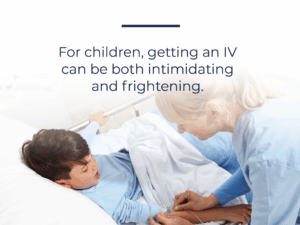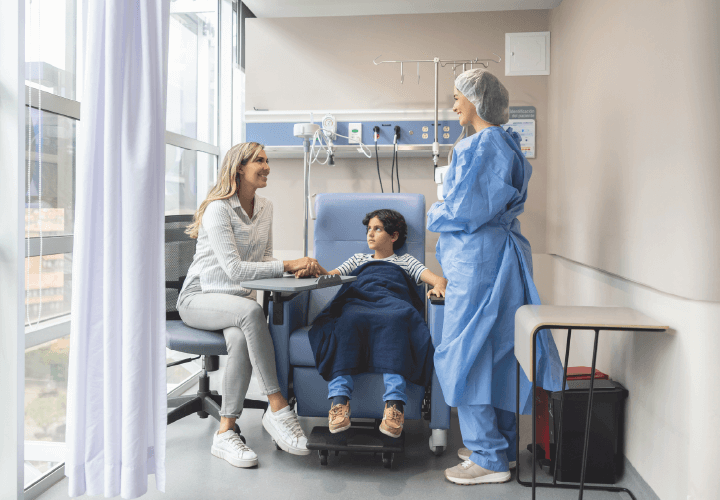- 3 MIN READ
How to Make Getting an IV Less Painful
Getting an IV is a common and relatively minor medical procedure, yet it can cause

Share:
Getting an IV is a common and relatively minor medical procedure, yet it can cause pain and discomfort for some patients. For many, even the thought of getting an IV can evoke feelings of apprehension and discomfort. Children, in particular, may find the experience intimidating and frightening.
IV lines are used worldwide to draw blood and administer medications and treatments. These procedures are very common and among the most frequent invasive procedures. However, sometimes they result in pain or discomfort for patients. Fortunately, with the right practices and compassionate care, it is possible to prioritize patient comfort and provide patient-centered healthcare that minimizes discomfort.
IV Tips and Tricks for Patients
Whether you have a patient facing their first-ever IV insertion or a patient with “tricky veins,” it’s crucial to put patients at ease and establish trust and comfort.
Here are five simple strategies to help patients prepare their veins and mind for a planned IV insertion:
1. Relax and Distract:
- A relaxed patient can help ensure the process goes smoothly. Patients can practice relaxation by:
- Taking deep belly breaths
- Looking away from the insertion site
- Watching a video on their device
- Having a conversation with a family member or caregiver
2. Promote Hydration:
- Veins are easier to find and insert locate, and harder to draw blood from or infuse fluids into, which can lead to repeated insertions and increased discomfort.
- When possible, encourage patients to drink plenty of water in the hours leading up to their procedure.
3. Warm the Area:
- Most hospitals maintain cooler temperatures. Veins may constrict slightly when patients feel cold.
- Encourage patients to dress warmly before their procedure or hold a warm compress to the insertion site to help warm the area.
4. Encourage Patients to Advocate for Their Needs:
- Sometimes simply voicing fear can help reduce stress. Encourage patients to communicate their fears and worries.
5. Establish Trust:
- Establishing trust before an invasive procedure can increase patient satisfaction. If something doesn’t go as planned, open communication promotes quick resolution and effective management of any discomfort.
For children who are nervous about IV procedures:
If you have a pediatric patient who is anxious about getting an IV inserted, several child-friendly steps can help put them at ease.
- Medical play can help children process and “work through” their medical experiences. Use child-friendly language and demonstrate medical procedures using medical play techniques.
- When possible, empower pediatric patients by allowing them to touch, hold, and play with medical equipment (even play equipment).
- Where appropriate, ask the caregiver to bring in a toy or beloved stuffed animal.
IV-line Insertion is Just the First Step to IV Treatment
Once the IV is inserted and the insertion site is covered with an appropriate IV dressing, an important step is to monitor the line for potential complications. IV care and maintenance is critical to ensuring safe, stable, and comfortable access throughout the treatment duration.
Additionally, some patients may experience discomfort or skin issues related to the medical adhesives used to cover and secure the IV line. Understanding a patient’s risk for skin injury can help providers avoid post-insertion complications. Different types of medical adhesives, such as silicone, can be used as gentler alternatives to traditional acrylic-based adhesives. Following best practices for application and removal of dressings, along with the use of skin protectants or adhesive removers can also help protect skin and prevent complications.
What May be Happening When IV Lines Are Painful
Are IV line insertions painful? And why may some IV lines cause discomfort, while others seem to be present without much, if any, issues?
Generally, having an IV should not be painful. Yes, the insertion may cause slight discomfort, but if a patient experiences pain, or is continually bothered by their IV line, there may be an underlying issue. It’s important for patients to feel comfortable communicating any concerns to their healthcare provider.
Several factors can contribute to IV-related pain and discomfort:
- Following IV-line insertion, superficial thrombophlebitis (clotting of the vein at the IV site) can occur and cause pain or discomfort.
- IV insertion can cause mild to severe forms of phlebitis (the often-painful swelling and irritation of the walls of a vein).
- The dressing used to secure the IV line may cause irritation or a skin reaction.
- Infection at the insertion site can also cause pain and discomfort.
While these experiences can usually be resolved, some cases of painful IV sites may indicate more serious peripheral intravenous catheter (PIVC) complications. Intravascular catheter sepsis, or catheter-related bloodstream infection (CRBSI), is a serious complication that can occur, carrying a higher risk of long-term health consequences and even death.
Compassion and Technology
At Covalon we believe that healing shouldn’t hurt. Common medical procedures should be as pain-free as possible. Integrating medical technology with a compassionate approach has the potential to enhance the overall experience during medical procedures. This approach is focused on supporting the well-being of patients, caregivers, and healthcare teams alike, striving for a process that is as smooth and comfortable as possible.
Resources:
- Peripheral Line Placement – National Library of Medicine
- Preventing medical adhesive-related skin injury (MARSI) – National Library of Medicine
- Multivariate analysis of medical adhesive-related skin injury at the site of peripherally inserted central catheter insertion in cancer patients: A prospective cohort study – National Library of Medicine
- Cleveland Clinic – Peripheral IV
- National Library of Medicine – Peripheral nerve injury from intravenous cannulation
- Mount Sinai – Superficial thrombophlebitis
- NHS – Phlebitis
- National Library of Medicine – Consequences of intravascular catheter sepsis
- National Library of Medicine – Catheter-related bloodstream infections
Covalon
If you are an individual reading this, please consult your health care provider before making any health care decisions, for guidance about a specific medical condition, and for use of any specific products. Covalon expressly disclaims responsibility and shall have no liability for any damages, loss, injury, or claim whatsoever suffered as a result of your reliance on any of the material or information contained in its blog articles or on the website
Related Blogs
Accurate wound measurement plays a vital role in wound care..
Intravenous (IV) therapy is a common medical procedure that involves..
The role of bedside nursing is becoming increasingly important as..






